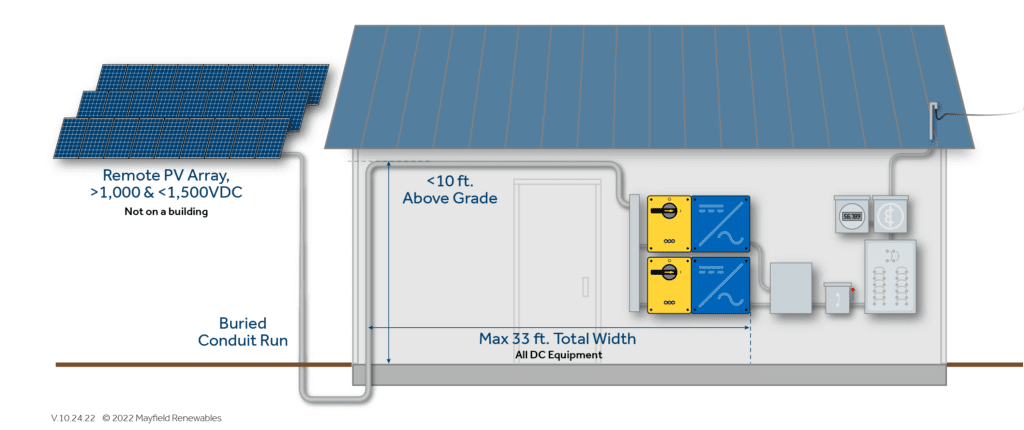Code Corner 2023 NEC 690.7 and 690.31(G)
In this episode of Code Corner, our founder Ryan Mayfield spells out 2023 NEC wiring methods and dc equipment location rules for systems over 1000 Vdc. Let’s take the relevant sections of Article 690 one at a time.
What does NEC 690.7 say?
690.7 Maximum Voltage. The maximum voltage of PV system dc circuits shall be the highest voltage between any two conductors of a circuit or any conductor and ground and shall comply with the following:
- PV system dc circuits shall not exceed 1000 volts within or originating from arrays located on or attached to buildings and PV system dc circuits inside buildings
- PV system dc circuits shall not exceed 600 volts on or in one- and two-family dwellings.
- PV system dc circuits exceeding 1000 volts shall comply with 690.31(G).
What’s changed about NEC 690.7 in 2023? Why does it matter?
This section describes constraints to follow for system voltages. In 2023, the format changed to match the NEC’s style guide and converted the three main requirements into a list. While subsection (1) might read slightly differently to the 2020 edition, the gist is the same. That is, if the PV system circuit originates from (or is across two points within) a rooftop or building-attached array, the potential difference must be no more than 1000 Vdc.
Subsection (2) is verbatim the same as the 2020 edition of the NEC. 600 Vdc is the circuit voltage limit for PV systems in one- or two-family dwellings.
However, subsection (3) is new to 2023 and points to new allowances for system voltages over 1000 Vdc and under 1500 Vdc. These allowances are spelled out in a section that’s new to the NEC 2023, section 690.31(G).
NEC 690.31(G) is new! What does it say?
690.31(G) Over 1000 Volts DC. Equipment and wiring methods containing PV system dc circuits with a maximum voltage greater than 1000 volts shall comply with the following:
- Shall not be permitted on or in one- and two-family dwellings.
- Shall not be permitted within buildings containing habitable rooms.
- Where installed on exterior of buildings shall be located less than 3 m (10 ft) above grade. Wiring methods containing PV system dc circuits connected to this equipment shall not be permitted to attach to the building greater than 10 m (33 ft) along the building surface from equipment.
What does that mean, and why does it matter?
This new section guides the wiring methods for PV systems with operating voltages between 1000 and 1500 Vdc.
Subsection (1) reinforces section 690.7(2) that one- or two-family dwellings are off-limits for nominal circuit voltages above 600 Vdc. This requirement reinforces the restriction already in the charging statement of 690.7.
690.31(G)(2) excludes the wiring methods under discussion from being used on buildings that include any habitable rooms. The NEC defines a ‘habitable room’ as “[a] room in a building for living, sleeping, eating, or cooking, but excluding bathrooms, toilet rooms, closets, hallways, storage or utility spaces, and similar areas.”
Our interest is primarily directed at subsection (3). It represents a new option for the location of equipment and wiring methods containing PV system dc circuits of any PV system with nominal voltages above 1000 Vdc, provided specific details are closely followed:
- The installation methods cannot exceed 3 m (10 ft) in height, measured from grade.
- The width of wiring methods and any dc equipment (for example, conduits or inverters) running along the building doesn’t exceed 10 m (33 ft).
See a visualization of these requirements below.

Before the 2023 NEC, placing dc circuits greater than 1000 Vdc on a building’s exterior was not allowed. So, while the dimensions (33 ft wide, 10 ft tall) are somewhat limiting for equipment locations, having this option is new to 2023 and could be helpful in specific installation scenarios. For example, this new allowance is good news for any installer with a ground mount system on a more compact site with an adjacent building.
Bonus 2023 NEC update: Article 495
Another key change from NEC 2020 to NEC 2023 is the disappearance of Article 490 and the appearance of 495. Section 690.7 of NEC 2020 mentions that PV systems less than 1500 VDC do not need to comply with certain sections of Article 490.
However, when dealing with PV systems of this size (1000 to 1500 Vdc), there is no need to thumb through Chapter 4 of the 2023 NEC. The new edition has no Article 490 and has replaced it with Article 495, entitled Equipment Over 1000 Volts ac, 1500 Volts dc, Nominal. Since the nominal voltage range of PV systems under the present discussion maxes out at 1500 Vdc, Article 495 does not apply when working in any jurisdiction that has adopted NEC 2023.
You can also find this episode more of our Code Corner videos on the Mayfield Renewables YouTube channel. Want to ensure your design complies with NEC 2023? Our System Design & Engineering team is happy to help. Contact us to start a project or learn more.










